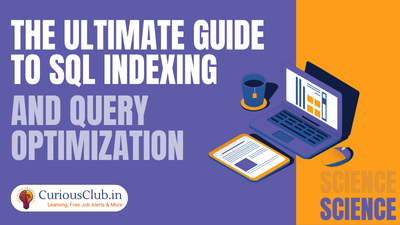
Introduction: SQL Indexing and Query Optimization
SQL indexing is a critical concept that can drastically improve query performance. Without proper indexing, your database might suffer from slow queries, high resource consumption, and performance bottlenecks. This guide covers everything you need to know about SQL indexing, with links to detailed articles on each topic.
By the end, you’ll understand:
- How indexes work and why they matter.
- The different types of indexes and their use cases.
- Best practices to avoid common pitfalls.
- How to analyze and optimize query execution plans.
Each section below links to a dedicated article for an in-depth exploration. Let’s dive in!
1. What is SQL Indexing and Why is it Important?
Indexing helps the database find data faster by avoiding full table scans. This introductory article explains indexing fundamentals, how indexes are stored, and why they are essential.
📖 Read more: SQL Indexing Explained: A Beginner’s Guide
2. Single-Column Indexes: How They Work and When to Use Them
A single-column index improves query performance for searches, sorting, and filtering on a specific column. Learn how to create and use them effectively.
📖 Read more: Single-Column Indexes: How They Work and When to Use Them
3. Multi-Column Indexes: When You Need More Than One Column
When queries filter on multiple columns, multi-column indexes (also called composite indexes) can be more efficient. Discover when and how to use them properly.
📖 Read more: Multi-Column Indexes: When You Need More Than One Column
4. Covering Indexes: Boosting Query Performance
A covering index stores all required columns within the index itself, eliminating extra lookups. Learn how covering indexes reduce I/O operations and enhance query speed.
📖 Read more: Covering Indexes: Boosting Query Performance
5. Clustered vs. Non-Clustered Indexes: Key Differences
Understanding clustered vs. non-clustered indexes is crucial for performance tuning. This article explains their differences and when to use each.
📖 Read more: Clustered vs. Non-Clustered Indexes: Key Differences
6. Advanced Indexing Strategies for Complex Queries
Some queries require specialized indexing techniques like filtered indexes, partial indexes, and full-text indexes. This article covers advanced strategies for real-world performance tuning.
📖 Read more: Advanced Indexing Strategies for Complex Queries
7. Index Maintenance & Optimization Strategies
Indexes require regular maintenance to remain effective. Learn how to monitor, rebuild, and reorganize indexes for sustained performance.
📖 Read more: Index Maintenance & Optimization Strategies
8. Query Execution Plans & Advanced Optimization Techniques
To fully optimize SQL performance, you must understand query execution plans, EXPLAIN ANALYZE, and indexing impact. This guide walks through advanced query optimization techniques.
📖 Read more: Query Execution Plans & Advanced Optimization Techniques
Conclusion: Mastering SQL Indexing for Optimal Performance
Indexing is a powerful tool that can drastically improve database performance—but only when used correctly. By following these guides, you can ensure your SQL queries are efficient, scalable, and optimized.
🚀 Ready to optimize your SQL queries? Explore the articles linked above and start implementing indexing best practices today!
For more SQL performance tips, stay tuned for our upcoming guides! 📌
Join Telegram | Join WhatsApp Channel
We hope this article about SQL Indexing was helpful for you and you learned a lot of new things from it. If you have friends or family members who would find it helpful, please share it to them or on social media.
Also Read:
- Mastering Pivot Table in Python: A Comprehensive Guide
- Data Science Interview Questions Section 3: SQL, Data Warehousing, and General Analytics Concepts
- Data Science Interview Questions Section 2: 25 Questions Designed To Deepen Your Understanding
- Data Science Questions Section 1: Data Visualization & BI Tools (Power BI, Tableau, etc.)
- Optum Interview Questions: 30 Multiple Choice Questions (MCQs) with Answers
Hi, I am Vishal Jaiswal, I have about a decade of experience of working in MNCs like Genpact, Savista, Ingenious. Currently i am working in EXL as a senior quality analyst. Using my writing skills i want to share the experience i have gained and help as many as i can.
